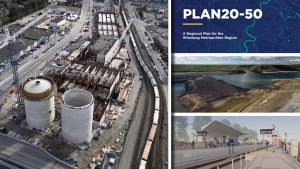With COVID-19 in full swing, Alberta’s construction industry has joined forces and come up with a new pandemic planning document to help companies that don’t have their own resources and need guidance.
“There are many, many companies in our industry who don’t have a dedicated safety person or department,” explained Calgary Construction Association president Bill Black who initially brought the companies together. “Nobody had a pandemic plan of any significance leading up to this. It’s not something that industry has been faced with so a lot of this has literally been generated over the last two weeks.”
The guide has been published by the Alberta Construction and is now being distributed as an open-source document to construction companies big and small across the province – and to associations nationwide.
“The whole idea was to create a document that can be shared across the industry,” said Black. “This is really to help people hit the ground running and help companies who are struggling to start from scratch.”
Groundwork for the guide began a couple of weeks ago when it became obvious that the COVID-19 pandemic was gaining momentum. While larger companies in Alberta’s construction industry have plans in place in the event of such a crisis, many of the smaller operations do not due to limited resources.
Black figured it would be a good idea to pull together leaders from bigger and mid-sized contractors and come up with a best-practices guide the industry could follow. He didn’t have to push very hard, with firms like PCL and Ledcor and groups like the Alberta Roofing Contractors Association coming forward.
“It was really a remarkable display of community and leadership on the part of some of these larger organizations who were happy to share because the faster our industry gets up to speed the better for everybody. It shows the degree of awareness across our industry, the degree to which they want to respond and get up to speed and do the right thing. It’s important for people to continue construction but only if it’s safe.”
The 23-page guide covers everything from the importance of social distancing, hand-washing, jobsite sanitation and even cleaning and disinfecting portable toilets, as well as how to conduct site meetings, the importance of cleansing radios and cellphones and what to do if a worker exhibits possible signs of the virus.
The document outlines how to mitigate contact between workers by staggering coffee and lunch breaks, posting signage reminding workers to keep their distance, and separating PPE clothing that is hung up. It also covers risks posed by those working at home, noting that workers must respect strict security rules, as the risk of phishing or other attacks is on the increase with hackers seeking to exploit the situation.
Black noted that the guide isn’t just a box-checking exercise and active participation by both employers and workers is essential because the situation is changing rapidly and worksites need to adapt quickly.
“There’s going to be stuff people haven’t thought of yet that will happen. The idea of active participation is that the onus is on everybody and they have to be willing to respond as it changes because it will.”
The guide recommends that a COVID safety co-ordinator be appointed for each worksite and, if that’s not feasible because of the size of a project, that the function be carried out by the site superintendent.
Black said the co-ordinator would conduct regular inspections of the worksite to monitor adherence to COVID prevention procedures and monitor cleaning to verify that approved products and protocols are followed. The individual would also investigate any reports of workers not complying with the rules.
“On a really large site like the Calgary Cancer Centre you’re probably going to have a dedicated COVID safety co-ordinator. On a smaller site you might delegate that to your site supervisor or somebody else, but COVID safety co-ordination is going to need to become a responsibility of an individual.”
With COVID-19 spreading so quickly, many construction companies were moving into unknown territory, from a health and safety perspective, said Black. He hopes that by sharing information, and updating the guide as the situation changes, the industry will be able to respond consistently and quickly.
“This has been a true collaboration. We’re trying to teach a traditionally competitive industry how to collaborate. This isn’t about intellectual property. This is about safe worksites in an unprecedented situation.”











How do we download a copy of the guide please?
I would be interested.
Simon
Who can i contact to include Genano in the guide – http://www.genano.com for PLUG&PLAY air decontamination mobiles
Previously used with SARS,MERS and currently around the world for Covid-19 – how to get the word out this is available in Canada, USA..
How do we get a copy of this guide? Thanks
Can you send me the link to download this guide
How do I obtain/download a copy of the guide?